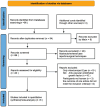Effectiveness of intravitreal ranibizumab for diabetic macular edema in vitrectomized versus non-vitrectomized eyes: a Meta-analysis
- PMID: 38638245
- PMCID: PMC10988062
- DOI: 10.18240/ijo.2024.04.18
Effectiveness of intravitreal ranibizumab for diabetic macular edema in vitrectomized versus non-vitrectomized eyes: a Meta-analysis
Abstract
Aim: To evaluate the effectiveness and safety of intravitreal ranibizumab (IVR) for diabetic macular edema (DME) in vitrectomized versus non-vitrectomized eyes.
Methods: The PubMed, EMBASE, Web of Science, Cochrane, EBSCO were comprehensively searched for studies comparing vitrectomized and non-vitrectomized eyes with DME. Clinical outcomes of best-corrected visual acuity (BCVA), central macular thickness (CMT), the mean number of intravitreal injection and adverse events were extracted and analyzed.
Results: Six studies involving 641 eyes were included. Final visual gain significantly improved and CMT significantly reduced in vitrectomized eyes at 6mo and 12mo visits (P<0.05). Although the mean reduction in CMT among non-vitrectomized eyes was significantly greater than in vitrectomized eyes at the 6mo [mean difference (MD)=53.57, 95% confidence interval (CI): 28.03 to 78.72, P<0.0001] and 12mo (MD=49.65, 95%CI: 19.58 to 79.72, P=0.01), no significant difference was detected in improvement in BCVA at either 6mo (MD=0.05, 95%CI: -0.02 to 0.13, P=0.14) or 12mo (MD=0.03, 95%CI: -0.04 to 0.09, P=0.43). Injection number of ranibizumab in non-vitrectomized eyes was significantly less than that in vitrectomized eyes during 6-month period (MD=0.60, 95%CI: 0.16 to 1.04, P=0.008), while there was no statistically significant difference between the two groups during 12mo of follow-up.
Conclusion: Evidence from current study suggests that IVR was useful for both vitrectomized group and non-vitrectomized group with DME. Although less reduction in macular thickness is found in vitrectomized group, visual improvement between two groups is similar.
Keywords: diabetic macular edema; ranibizumab; vitrectomized eye.
International Journal of Ophthalmology Press.
Conflict of interest statement
Conflicts of Interest: Wang YH, None; Xu Q, None; Luan J, None.
Figures



Similar articles
-
Effectiveness of Intravitreal Ranibizumab in Nonvitrectomized and Vitrectomized Eyes with Diabetic Macular Edema: A Two-Year Retrospective Analysis.J Ophthalmol. 2020 Aug 6;2020:2561251. doi: 10.1155/2020/2561251. eCollection 2020. J Ophthalmol. 2020. PMID: 32832135 Free PMC article.
-
Intravitreal Ranibizumab Versus Aflibercept for Diabetic Macular Edema in Vitrectomized Eyes: 12 Month Results.Semin Ophthalmol. 2021 Nov 17;36(8):723-727. doi: 10.1080/08820538.2021.1900287. Epub 2021 Mar 24. Semin Ophthalmol. 2021. PMID: 33760698
-
Comparison of efficacy of intravitreal ranibizumab between non-vitrectomized and vitrectomized eyes with diabetic macular edema.Int Ophthalmol. 2018 Feb;38(1):293-299. doi: 10.1007/s10792-017-0462-1. Epub 2017 Feb 7. Int Ophthalmol. 2018. PMID: 28176171
-
Efficacy and safety of the dexamethasone implant in vitrectomized and nonvitrectomized eyes with diabetic macular edema: A systematic review and meta-analysis.Front Pharmacol. 2022 Dec 1;13:1029584. doi: 10.3389/fphar.2022.1029584. eCollection 2022. Front Pharmacol. 2022. PMID: 36532786 Free PMC article.
-
Intravitreal steroids for macular edema in diabetes.Cochrane Database Syst Rev. 2020 Nov 17;11(11):CD005656. doi: 10.1002/14651858.CD005656.pub3. Cochrane Database Syst Rev. 2020. PMID: 33206392 Free PMC article.
References
-
- Guo HX, Li WB, Nie ZT, Zhang X, Jiao MF, Bai SQ, Duan NX, Li XR, Hu BJ. Microinvasive pars Plana vitrectomy combined with internal limiting membrane peeling versus anti-VEGF intravitreal injection for treatment-naïve diabetic macular edema (VVV-DME study):study protocol for a randomized controlled trial. Trials. 2023;24(1):685. - PMC - PubMed
-
- Teo ZL, Tham YC, Yu M, et al. Global prevalence of diabetic retinopathy and projection of burden through 2045:systematic review and meta-analysis. Ophthalmology. 2021;128(11):1580–1591. - PubMed
-
- Mitchell P, Bandello F, Schmidt-Erfurth U, Lang GE, Massin P, Schlingemann RO, Sutter F, Simader C, Burian G, Gerstner O, Weichselberger A, RESTORE study group The RESTORE study: ranibizumab monotherapy or combined with laser versus laser monotherapy for diabetic macular edema. Ophthalmology. 2011;118(4):615–625. - PubMed
LinkOut - more resources
Full Text Sources
